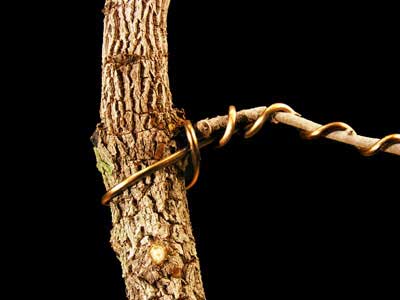Step 4 - Wiring Your Bonsai

Wiring is an important part of the process of styling your bonsai and nearly all well designed bonsai have been wired at some point in their development. By coiling wire around the limbs of the bonsai, the enthusiast is able to bend the tree into a desired position upon which it is held by the wire. In a matter of weeks or months, the branch or trunk 'learns' and stays in position even after the wire is removed. Bonsai wire is normally only available from Bonsai Nurseries and Online Shops. It is available as anodised aluminium or annealed copper; aluminium wire is generally easier to apply for beginners and can be reused. Copper wire is more difficult to apply but has more holding power. Once it is has set into position it cannot be re-used. Wire cutters are also necessary for removing wire from branches and for cutting suitable lengths. Bonsai wire cutters are available but ordinary wire cutters are adequate if the wire can be cut at the very end of the cutters jaws.
Where possible the wire should be applied at a 45° to the direction of the branch that is to be wired. Hold the beginning of the wire/anchor point firmly with your left hand at all times; as you coil the wire further down the branch, you can also move the position that you secure using this hand. At all times, the wire that has already been applied should not be able to move whilst you continue to wire the remainder of the branch. With the wire in your right hand, feed the wire through your thumb and first finger as you make a circling motion with your wrist around the branch, carefully work down the branch towards your body. You can either cut a length of wire approximately 1/3 longer than the branch you are wiring or as I prefer, you can keep the reel of wire in the palm of your hand and cut to length when you have reached the tip of the branch. Always wire from the base of the branch to the very tip.
Step 5 - Trimming and Pruning

Bonsai are ordinary tree species that require regular pruning to keep their diminutive shape. Without pruning, branches extend and the tree begins to lose its shape. Given enough uninterrupted growth, these branches can eventually thicken out of scale with the trunk and become coarse. Eventually, if left unpruned for long enough, a bonsai will simply revert to resembling an ordinary tree or shrub and the process of bonsai will need to be started again. In order to maintain the tree’s shape cut shoots through the stems just above a leaf. Do not be afraid to prune your Bonsai; it is important, especially in the outer and top areas, to prune regularly in order to force the tree to distribute growth more evenly and develop a dense foliage.
Instead of being pruned, pine trees and conifers should be pinched by hand. Using scissors to prune conifers would lead to dead brown foliage at the cuttings. To prevent this from happening hold the tip of the shoot between your thumb and pointing finger and carefully pull it away; the shoot will snap at its weakest point and no brown ends will appear. Another method of Bonsai pruning is defoliation, which involves removing leaves of deciduous trees during the summer to force the tree to grow new leaves. This technique ultimately leads to a reduction in leaf size.
